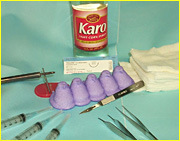Junk food research (and Turing machines)
Sunday, June 1, 2003
I return from my hiatus of several months to share three important pieces of “scientific” research with you.
1. Soft Drinks
Do you say “pop” or “soda” (or “coke,” if you’re from the South) when referring to carbonated soft drinks? During my childhood, I was teased on the East Coast when I said “pop” and mocked in the Midwest when I said “soda.” These days I prefer to use the term “soda.” I might also note that people seem to use the two words more interchangeably in Oregon. Read more about this soft drink study and view their maps of the United States at popvssoda.com.
 2. Peeps
2. Peeps
What happens when you torture Peeps? How do they react to heat, liquid nitrogen, low-pressure environments, and microwaving? Find out at peepresearch.org.
3. Twinkies
What happens when you torture Twinkies? T.W.I.N.K.I.E.S. is a series of experiments conducted during finals week, 1995, at Rice University. Learn more at twinkiesproject.com.
A Turing test was included among the scientific methods used in the Twinkies research. This test was designed to determine whether Twinkies are intelligent. Uh, it turns out they’re not.
But this is a good place to mention Turing machines, which are the simplest forms of computers. In addition to inventing the Turing machine, cryptographer Alan Turing helped Britain break the German Enigma machines during WWII.
![]() In 1970, mathematician John Conway invented a cellular automaton called Conway’s Game of Life, which is a system of rules that are applied to cells and their neighbors in a regular grid. I am fascinated by this stuff. There are a lot of places online where you can download Turing machine simulators in various programming languages, as well as Life patterns.
In 1970, mathematician John Conway invented a cellular automaton called Conway’s Game of Life, which is a system of rules that are applied to cells and their neighbors in a regular grid. I am fascinated by this stuff. There are a lot of places online where you can download Turing machine simulators in various programming languages, as well as Life patterns.
And if you can’t get enough of the junk food science, then take a look at the links available on the Peeps research site. There are all kinds of marshmallow-based pseudoscientific resources on the Internet, plus Pop-Tarts experiments, SPAM worship, and more.